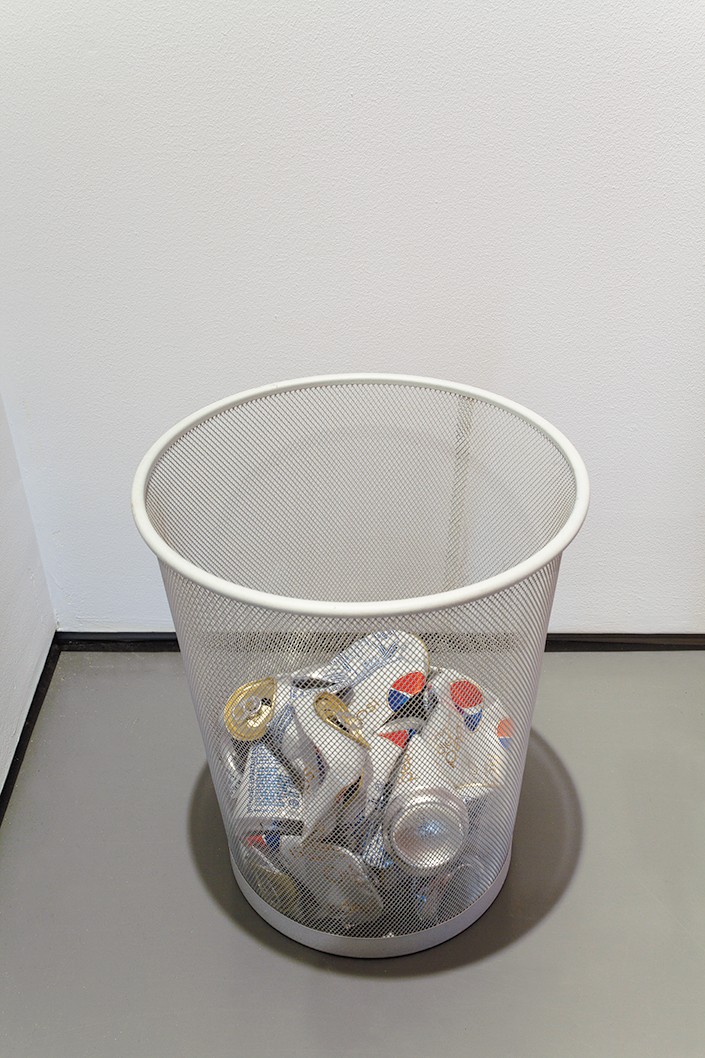Cory Arcangel
At the time of viewing Cory Arcangel’s exhibition “Power Points” at DHC/ART, I was researching the visual arts influences on Samuel Beckett’s aesthetics, which he gathered during a six-month “artistic pilgrimage” to Germany in 1936–37. One of the best known was that of Two Men Contemplating the Moon by Caspar David Friedrich, which Beckett appreciated for its bémolisé or “minor key” effect. Perhaps it is because I was looking for it in an attempt to locate myself within an otherwise alienating technological topography that I found something of the bémolisé here, beyond or within all the noise, pattern, and spectrum of “Power Points.”

Cory Arcangel, Sans Caféine, 2013. Courtesy DHC/ART Fondation pour l’art contemporain. Photograph: Richard-Max Tremblay.
Like Friedrich and Beckett, Arcangel plays heavily (indeed, “play” being the operative word) on repetition and a movement towards “lessness” as he reduces video to single lines of pixels, translates cyber-movement into patterns of colour and sound, and sets his own limits to technological process and progress so that momentum works in the boomerang effect of out and back. As such, departure and arrival loop into one another and we are caught in a mesmerizing cycle, waiting for something to occur that never does, and in the process or pause become drawn into the rhythm of redundancy, which seems to convincingly imitate anticipation.
As I stand in front of Self Playing Nintendo 64 NBA Courtside 2, 2011, a large projection of a hacked Nintendo 64 video game featuring Shaquille O’Neal endlessly shooting the ball but never sinking the shot, I am made to think of Beckett’s oft-appropriated words from “Worstward Ho”—“Fail again. Fail better.” Only here, Shaq does not fail any better or worse—his is a programmed failure of sameness in an empty arena, its vacuity offering a renewed (if dwindling) sense of expectation in the booming echo of the ball bouncing before its launch. DHC provides a basement variety couch, allowing an observer to indulge in the rhythm that emerges in the panning between a pop-culture version of the Rückenfigur and his constantly thwarted “prospect view” of the failed shot, and the facial pre-shot zoom, revealing a consistently ambiguous emotion that could be interpreted as hope or conversely, as resignation. Given enough time, the sequence which starts out humorously produces an obsessive uneasiness.
A similar anxiety is achieved in Sweet 16, 2006, as Arcangel applies the avant-garde concept of phasing to align two Guns N’ Roses video clips just out of tempo with one another. This looping frustrates the progress of the famous introductory riff to “Sweet Child O’ Mine,” which, through the momentum implied in the repetition of three simple chords coupled with the deeply engrained cultural memory of this 1980s anthem, is surprisingly effective in evoking an almost unbearable anticipation for the thing to start.

Cory Arcangel, Self Playing Nintendo 64 NBA Courtside 2, 2011. Courtesy DHC/ART Fondation pour l’art contemporain. Photograph: Richard-Max Tremblay.
Another slightly out of synch exercise of call and response is Permanent Vacation, 2008, in which two Apple iMacs are caught in a seemingly endless “out of office” email loop. Like a script in some absurdist theatre, it reads as a vain attempt on the part of modern man to echolocate himself in the void. This back and forth will continue until the system ultimately crashes, which recalls Kant’s dictum (or a reversal thereof) of “purposiveness without purpose”—a concept that Beckett knowingly applied in his narratives of “motion in a stasis,” which are, in fact, what Arcangel often offers us. Using the “loop,” indeed the predominant geometry of the collection, the artist produces a generalized anxiety based on an entropic tension inherent in the paradox of technology’s promise of “progress” or in the perceived limitlessness of the Internet. It’s here that technological hardware becomes a platform or precipice from which to contemplate a modern sublime vista. However, the “cyber void,” as Arcangel demonstrates, is actually a system formed of parameters in constant threat of being broken down by the central mechanics of his work: repetition is both the driving and ultimately arresting force that will cause the ubiquitous and dreaded technological “crash.” No doubt what is of interest to Arcangel is the knowledge that these limits exist, while lacking the certainty of the exact distance to be travelled in order to reach them.
Within Arcangel’s celebration and parody of popular culture by way of modified video games, altered music videos and movies, hacked computer programs, DIY instructions generously offered on his website, intricately pieced compositions made of YouTube clips of piano-playing cats, there can be found the echo and shadow of darker themes of absence and disconnection in a constant minor key of thwarted expectation. Confronting these works, the screen becomes the rupture point between subject and object and code becomes a virtual symbol for social alienation within an actual world. But not all the pieces are made of bells and whistles and the most blatantly bémolisé, so quiet that it could easily be missed or assumed evidence of the gallerist’s habits, is Sans Caféine, 2013. In the tradition of the readymade, the piece is simply a wastebasket filled with crushed empty cans of locally purchased (and presumably locally consumed) Pepsi Diet Zero, providing a static and more literal version of emptiness and repetition while making a subtle comment on globalized consumerist behaviour. Accustomed now to the trickery and mechanics of the Arcangel oeuvre, I find myself standing before it waiting for something to happen, and of course, nothing ever does.
“Cory Arcangel: Power Points” was exhibited at DHC/ART, Montreal, from June 21 to November 24, 2013.
Tracy Valcourt is a writer living in Montreal

